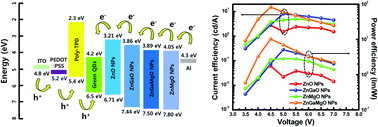Optimization of the electron transport in quantum dot light-emitting diodes by codoping ZnO with gallium (Ga) and magnesium (Mg)†
Abstract
In our study, to optimize the electron–hole balance through controlling the electron transport layer (ETL) in the QD-LEDs, four materials (ZnO, ZnGaO, ZnMgO, and ZnGaMgO NPs) were synthesized and applied to the QD-LEDs as ETLs. By doping ZnO NPs with Ga, the electrons easily inject due to the increased Fermi level of ZnO NPs, and as Mg is further doped, the valence band maximum (VBM) of ZnO NPs deepens and blocks the holes more efficiently. Also, at the interface of QD/ETLs, Mg reduces non-radiative recombination by reducing oxygen vacancy defects on the surface of ZnO NPs. As a result, the maximum luminance (Lmax) and maximum luminance efficiency (LEmax) of QD-LEDs based on ZnGaMgO NPs reached 43 440 cd m−2 and 15.4 cd A−1. These results increased by 34%, 10% and 27% for the Lmax and 450%, 88%, and 208% for the LEmax when compared with ZnO, ZnGaO, and ZnMgO NPs as ETLs.



 Please wait while we load your content...
Please wait while we load your content...